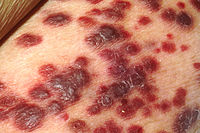
Photo from wikipedia
GGG GCC (G4C2) repeat expansion in the first intron of C9ORF72 is the most common genetic cause of amyotrophic lateral sclerosis (ALS) and frontotemporal dementia (FTD) [6, 11]. Brain tissues… Click to show full abstract
GGG GCC (G4C2) repeat expansion in the first intron of C9ORF72 is the most common genetic cause of amyotrophic lateral sclerosis (ALS) and frontotemporal dementia (FTD) [6, 11]. Brain tissues from affected individuals show characteristic nuclear RNA foci containing the expanded repeat RNAs, as well as neuronal inclusions containing dipeptide repeat (DPR) proteins [poly(GA), poly(GP), poly(GR), poly(PR), and poly(PA)] resulting from the translation of both sense and antisense repeat RNAs in all reading frames [4, 9, 14]. Although reduced C9ORF72 protein function may contribute to disease [10], the more likely drivers of disease are mechanisms related to a gain of toxic function [7]. Currently, intense efforts are being made to identify disease mechanisms amenable for the development of therapeutic strategies. One promising avenue would be to prevent the production of the expanded repeat RNAs, such as by antisense oligonucleotides [5]. Here, we tested another potential therapeutic approach: CRISPR/Cas9-based targeting of the promoter region. In ALS and FTD patients, transcription initiated at exon1a of C9ORF72 generates RNA species containing G4C2 repeat expansions that are in turn translated into three DPR proteins, poly(GA), poly(GP), and poly(GR). Thus, we first used reporter constructs to identify the promoter sequence 5′ to exon-1a that is responsible for transcription initiation of expanded repeat RNA. We cloned the 435 nucleotides (nt) upstream of the predicted transcription initiation site, as well as several truncated fragments of the 435-nt sequence, into a luciferase reporter vector (Fig. 1a) and expressed all the constructs in HEK293 cells. Deletion of the first 301 nt did not reduce the relative expression of the reporter gene. However, deleting the remaining 134 nt abolished luciferase expression (Fig. 1a), indicating that the core promoter elements are located in this region. To further characterize this sequence, we also tested a construct lacking the first 394 nt and one lacking the remaining 41 nt. Each of these deletions reduced the relative luciferase expression, indicating that both constructs lacked a portion of sequence required for reporter gene expression (Fig. 1a). These experiments indicate that the last 134 nt sequence contains the minimal promoter necessary to drive expression of G4C2 repeat-containing C9ORF72 transcripts. To investigate how this deletion affects the production of RNAs containing G4C2 repeat expansions in C9ORF72 human neurons, we used CRISPR-Cas9 technology to generate a similar deletion 5′ to exon-1a of C9ORF72 in an induced pluripotent stem cell (iPSC) line containing ~ 1000 copies of the G4C2 repeats [2] (Figs. 1b, c; S1). We selected two iPSC lines containing the promoter deletion and differentiated them and the parental iPSC line into ChAT-positive motor neurons (see Suppl. Information). As expected, the promoter deletion eliminated the expression of C9ORF72Variant 3 (V3), whose transcription starts on exon-1a (Fig. 1b, d). In contrast, the RNA level of C9ORF72-V2, whose translation starts on exon 1b, or the expression of C9ORF72-antisense RNA, was not significantly affected Gopinath Krishnan and Yu Zhang contributed equally to this work.
Journal Title: Acta Neuropathologica
Year Published: 2020
Link to full text (if available)
Share on Social Media: Sign Up to like & get
recommendations!